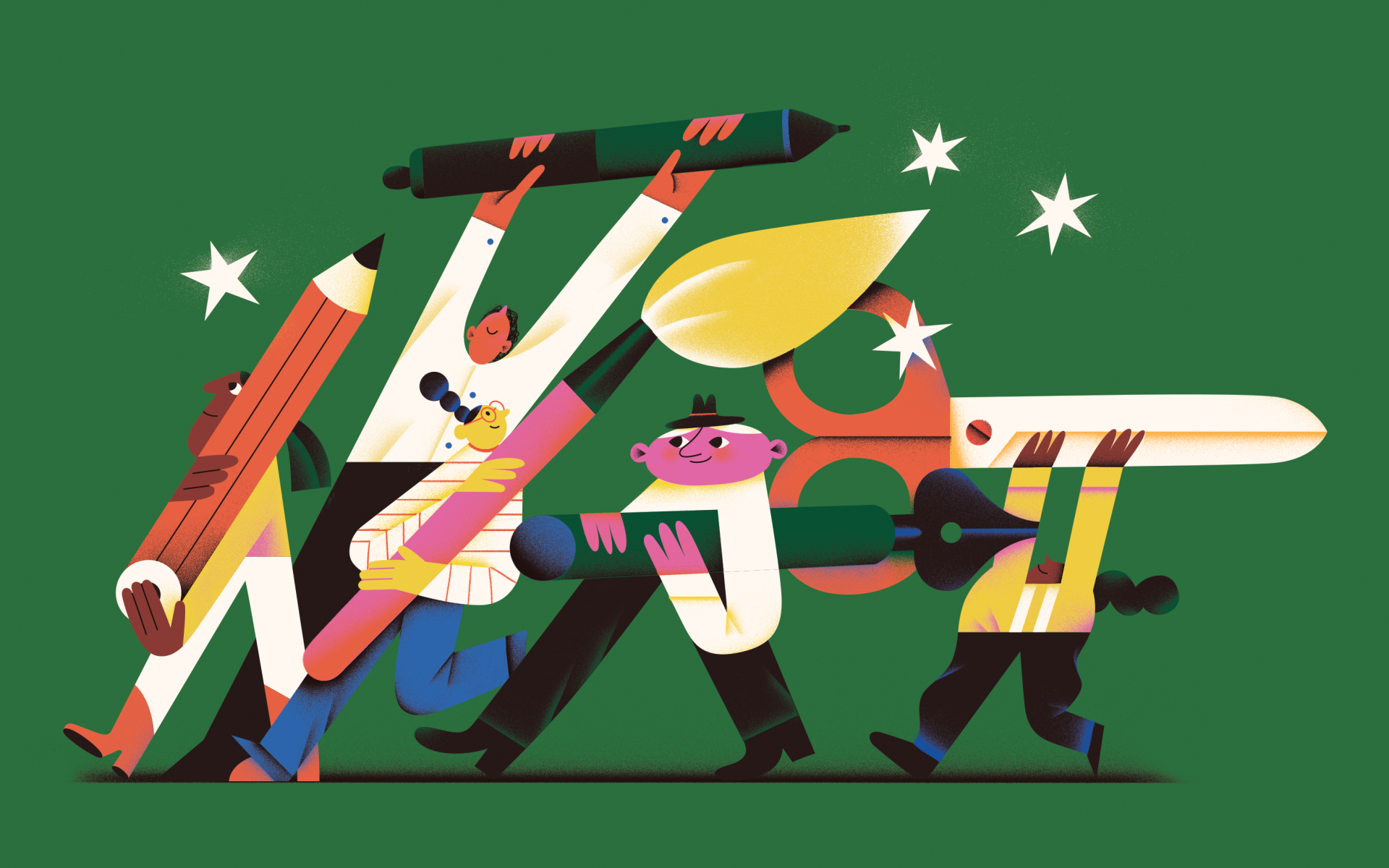How to start as an illustrator: 6 Tips and Insights

A career in illustration doesn’t just involve drawing and creating nice things, it also means being a business – promoting yourself, contacting clients, quoting and licensing, writing and reviewing contracts, invoicing and more. It may initially seem daunting, but here at the AOI we support illustrators throughout their careers in many ways through our members’ helpdesk, resources, industry discounts and events.
We aim to demystify the business side of illustration and help support graduates and illustrators who are starting out. Below we share the main points you need to consider…
Build a portfolio
- Work on your portfolio and take the time to explore and get clear on who you are as an illustrator. There are artists who develop their own very identifiable, ownable style and then there are more multidisciplinary artists who may have many different skills, and that’s ok too. The most important thing is conveying your strengths and showcasing your work in the best light. Don’t include any pieces in your folio that you don’t love or that isn’t the kind of work you’d want to get commissioned for. It seems obvious but it’s important to remember: the work in your portfolio will be the kind of work that you’ll be commissioned for.
- Carefully curate your portfolio. Quality over quantity. Don’t be overly worried if your portfolio is lacking in commercial projects (after all you’re just starting out!) but it’s important to get a sense of how your work can be used commercially. Give the illustration some context in the form of relevant mock ups. For example, this could be to show how your series of illustrations could be applied to some packaging, or as part of a brand identity, or an advertising campaign used for print and digital/social. Or if publishing is more your thing, perhaps it’s experimenting with your own visual interpretation of a story.
- Passion projects are just as important as client work and can really help you land the next client commission. They allow you to essentially write your own brief and to communicate what makes you tick, letting your imagination and creativity run wild. This is often some of your best work. There’s been times where illustrators have put out some personal work that they’ve created in their downtime or in between projects, and that is the work that gets picked up and referenced on client mood boards. Don’t underestimate it.
- When creating your website, make this simple and easy to use with clear navigation and a layout that really hero’s the work and instantly gives a potential client an overview of you and what you’re about. Clients are often limited on time and it’s beneficial to think about how easy it is to find your work and contact details. We’d recommend using a clear format email address that showcases your name/illustration name and steering clear of contact forms. Have your email address and all web presences clearly visible.
- When curating your online folio you may want to think about putting the work into categories such as subject matter or type of medium or discipline. If you have complimentary skills such as animation, hand lettering, drawing at live events, etc, include those too – just make sure your additional skills are relevant.
Set yourself as a business
- Any creative industry professional working for themselves will need to register as a self-employed/soletrader on HMRC website. This helps make the government aware of where you’re making money and you’ll need to file a self-assessment each year before the end of January. You still need to do this, whether or not you bring in an annual income below your taxable personal allowance. The standard Personal Allowance is £12,570, which is the amount of income you do not have to pay tax on.
- Our advice would be to track what money is coming into you and going out. Keep hold of proof of such as receipts as you’ll need them for your tax return. It’s good practice to put aside 20 -30% of all income for your taxes. AOI members can get 1 hour free with an accountant to find out more and can view our top tips for accounting resource.
- It is rare for a business to turn a profit in the early years, and many illustrators will initially need to find alternative income to support them whilst developing their illustration career. This is very normal. The AOI can still advise you in this crucial time.
- We have some exclusive business consultations available to members. Book yourself in – and check out the resources which go with them. Business Consultations target the questions all freelancers should be thinking about in more depth.
- You should grow your knowledge around business essentials like copyright, finances and contracts. We have a huge range of resources and offer advice on pricing and licensing as we understand these things can be a little tricky, especially when first starting out.

Promote yourself
- Self-promotion is really important, so think about how you can stand out from the crowd and what you have to offer. What is your point of difference? Prospective clients/agents need to see what makes you, you.
- Be confident! Don’t be afraid to put yourself out there and don’t be disheartened if you don’t hear back from people right away. This is often not a reflection on you, people are very busy – it’s about being tenacious! It’s totally ok to follow up after a few weeks, and even send an update with some strong new work later down the line, like a strong series of illustrations produced as a passion project.
- Keep your social channels and profiles up to date. Instagram is a great platform to help showcase your work,allowing you to follow industry experts and agencies and keeping you informed with the going ons within the industry, helping to build connections. A lot of Art Directors have been using platforms like Instagram to keep track of talent, so it’s definitely worth using this as a portfolio platform if you don’t already. Of course you should follow @theaoi so you can see who we’re following and get an immediate insight into what’s happening in illustration, and how your industry is using each platform. From there you can follow people and companies relevant to your work.
- The more content you put out about yourself, your work and abilities on your socials, the more likely you are to gain the attention of those you are looking to impress. You can check out our Guide to Using Instagram Effectively.
- The AOI also offer membership that comes with an online folio on the website, with the benefits of promotion across AOI social media and direct promotion to commissioners. Alongside this, members also receive a free 10 image portfolio with Directory of Illustration in the USA for an even broader reach.
Research and build your network
- Research is super important – reading creative blogs, and online magazines such as It’s Nice That, Campaign, LBB, Digital Arts, Creative Boom, Lecture in Progress, The Bookseller, etc also helps keep you up to date with the industry. Doing your research will hold you in good stead and help you to get a clearer insight on the agencies and work you really like, the kind of work you want to be doing and who you’d like to work with. Utilizing platforms such as LinkedIn can be really beneficial. This can help build one-on-one relationships with potential clients, employers and partners.
- When reaching out to clients, make it personable – if there’s a particular project of theirs you love, let them know!
- Attend events on and offline, build your network and make connections wherever you can. The AOI host events and meet-ups in various cities around the UK for members and non-members. These are starting to be in real life again since the pandemic and a really great way to meet other illustrators. Community and building a support group is very important. You can also check out a range of industry events on the AOI website.

Collaborate
- Collaboration is another great way to meet people and build your network. Working with someone who has a different skillset to you allows you to learn from them but also can take the work to new heights. Motion is very popular. As an illustrator, collaborating with an animator gives the illustration a whole new dynamic.
- By no means are you expected to be an animator as well as an illustrator, but having a very basic knowledge of animation, in a time where even editorial clients occasionally want a gif for their digital version, can be useful. Even if that is to better communicate with an animator how you envision your illustration coming to life and learning how best to prepare your illustration assets for animation. With the internet and advances in technology you can easily learn these skills from the comfort of your own home (as many other creatives have done so far!).
- Sharing studio space with other freelancers or taking on an internship can also be really valuable in gaining first-hand experience in the industry and how it works. Internships should always be paid!
- Know your worth. Just because you’re new it doesn’t mean you don’t have a lot to offer. The same is to be said for pricing your work.
Be resilient
- Don’t put too much pressure on yourself to be the finished article straight out of university or in the beginning of your profession – it takes time to find your niche and build a career. It’s an ongoing process and should be a fun one. Explore, play, create, connect. See what feels right for you and don’t be afraid to reach out and ask other people’s opinion. It’s hard to be objective about your own work, so asking others to give feedback can be really valuable. Members can book a portfolio consultation, These are suitable for early career illustrators, those looking to change direction, or just freshen up their portfolio.
- Don’t be afraid to make mistakes. Mistakes are an essential part of progress and don’t mean failure. Sometimes the best things can come out of a mistake. The same with a No. If you receive a no it just means ‘Next Opportunity.’ Our advice is to keep going, be resilient, positive and enjoy the journey. Keep taking action, even when you may feel disheartened by a job falling through or experiencing a quiet patch; this happens to all, so know in those moments you are not alone. Remember to look after yourself and your mental health. We have some wonderful tips you can read here.
What’s one small step you can take today that will help you get closer to where you want to be?
The very act of taking action builds confidence. You’ve got this!
In the upcoming months we’re hosting a range of webinars that cover these topics in more detail. Some useful dates for your diary below – we hope to see you there!
* Taking Charge and Starting Out as an Illustrator (Thursday 16th June, 13:00 BST)
Book your space here.
* Understanding Contracts Better (Thursday 30th June, 13:00 BST)
Book your space here.
* Negotiating with Confidence (Thursday 28th July, 13:00 BST)
Book your space here.
* An Insight into Illustration Agents (Thursday 8th September 13:00 BST)
Book your space here.
Back to News Page
